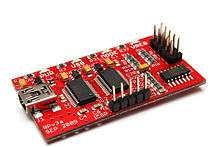Bus Pirate

The Bus Pirate is a universal electronic open hardware tool to program and interface with communication buses and program various chips, such as AVRs from Atmel and PICs from Microchip Technology. A primary usage case for this device as intended by the designers is to "Eliminate a ton of early prototyping effort with new or unknown chips."[1] Using a Bus Pirate, developers can use a serial terminal to interface with devices over a variety of hardware protocols, such as SPI and 1-Wire.
The Bus Pirate is based on an PIC24 MCU (SSOP), and implements a USB interface with a FT232RL (SSOP).
Feature list
Support for many serial protocols with line levels of 0 – 5.5 volts:
- 1-Wire
- I²C
- SPI
- JTAG
- Asynchronous serial
- MIDI
- PC keyboard
- HD44780 LCD
- 2- and 3-wire libraries with bitwise pin control
- Scriptable binary bitbang, 1-Wire, I2C, SPI, and UART modes
Other capabilities:
- 0 – 6 volt measurement probe
- 1 Hz – 40 MHz frequency measurement
- 1 kHz – 4 MHz pulse-width modulator, frequency generator
- On-board multi-voltage pull-up resistors
- On-board 3.3 volt and 5 volt power supplies with software reset
- Macros for common operations
- Bus traffic sniffers (SPI, I²C)
- A bootloader for easy firmware updates
- Transparent USB -> serial mode
- 10 Hz – 1 MHz SUMP compatible low-speed logic analyzer
- AVR STK500 v2 programmer clone
- Supported in AVRDude programmer
- Scriptable from Perl, Python, etc.
Hardware differences
4.x
The hardware differences between version 3.x to 4.x include: different microcontroller, different connector (from 5×2 to 6×2), and more.[2][3]
3.6
The PCB size was changed to 60 mm x 37 mm, so it would match the mounting holes for "Sick of Beige" DP6037 case.[4]
References
- ↑ "Bus Pirate v3". Retrieved 19 December 2011.
- ↑ Bus Pirate v4 vs v3 comparison; Dangerous Prototypes.
- ↑ Bus Pirate v4.0
- ↑ Bus Pirate v3.6